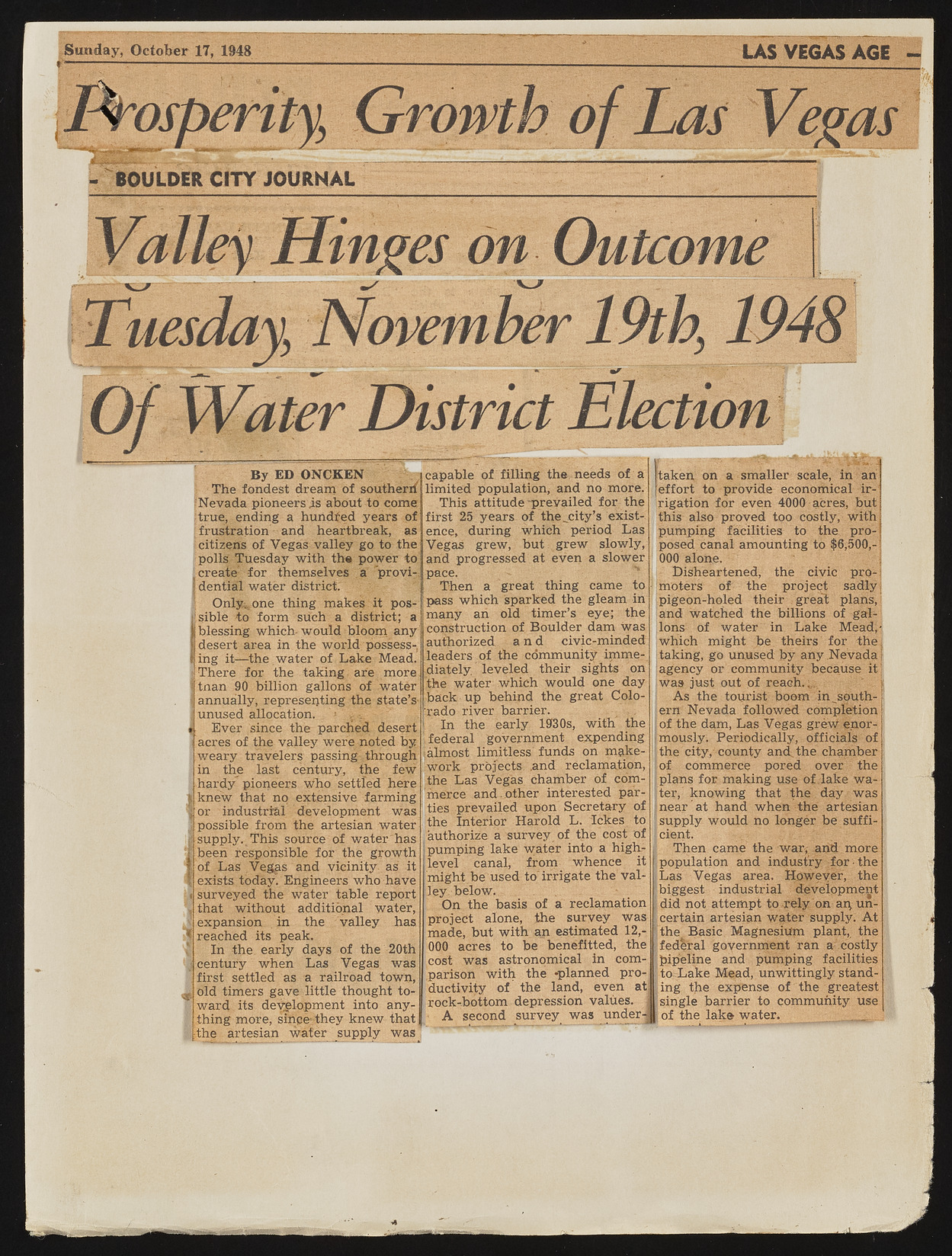Copyright & Fair-use Agreement
UNLV Special Collections provides copies of materials to facilitate private study, scholarship, or research. Material not in the public domain may be used according to fair use of copyrighted materials as defined by copyright law. Please cite us.
Please note that UNLV may not own the copyright to these materials and cannot provide permission to publish or distribute materials when UNLV is not the copyright holder. The user is solely responsible for determining the copyright status of materials and obtaining permission to use material from the copyright holder and for determining whether any permissions relating to any other rights are necessary for the intended use, and for obtaining all required permissions beyond that allowed by fair use.
Read more about our reproduction and use policy.
I agree.Information
Digital ID
Permalink
Details
Member of
More Info
Rights
Digital Provenance
Publisher
Transcription
Sunday, October 17, 1948 gigpig LAS VEGAS AGE - Nosperiity Grotvth o f jLas Vegas - BOULDER CITY JOURNAL Valley Hinges on Outcome Tuesday\ November 19th; 1948 ^ ~ - y - - -"y ? :v ?? ’ ’ O f W ater District Election By ED ONCKEN The fondest dream of southerrf ^Nevada pioneers is about to come ;true, ending a hundfed years of frustration • and heartbreak, as citizens of Vegas 'valley go to the polls Tuesday with the power to (create for themselves a provi-; I dentiai water district. » Only,,, one thing makes it possible to form such a district; a blessing which- would bloom, any desert area in the world possess-, ing it—the water of Lake Mead. There for the taking are more tnan 90 billion gallons of water annually, representing the state’s unused allocation. *' ^.j. ? Ever since the parched desert acres of the valley were noted by weary travelers passing through in the last century, the few hardy pioneers who settled here knew that no extensive farming or industrial development was possible from the artesian water supply..This source of water has been responsible for the growth of Las Veggs and vicinity- as it exists today. Engineers who have surveyed the water table report that without additional water, expansion in the valley has reached its peak. In the early days of the 20th century when Las Vegas was first settled as a railroad town, bid timers gave little thought toward its development into anything more, stepe-they knew that the artesian water supply was i capable of filling the, needs of a limited population, and no more. This attitude’prevailed for the first 25 years of thejcity’s existence, during which period Las Vegas grew, but grew slowly, and progressed at even a slower pace. Then a great thing came to pass which sparked the gleam in many an old timer’s eye; the construction of Boulder dam was authorized a n d civic-minded leaders of the community immediately. leveled their sights on the water which would one day hack up behind the great Colorado river barrier. In the early 1930s, with' the , federal government expending salmost limitless' funds on make- Work projects, .and reclamation, the Las Vegas chamber of commerce and .other interested parties prevailed upon Secretary of the Interior Harold L. Ickes to authorize a survey of the cost Of pumping lake water into a high-level canal, from whence it might be used to" irrigate the valley, below. On the basis of a reclamation project alone, the survey was made, but with up estimated 12,- 000 acres to be benefitted, the cost was astronomical in comparison with the planned productivity of the land, even atj rock-bottom depression values. J A second survey was under J taken on a smaller scale, in an effort to provide economical irrigation for even 4000 acres, but this also proved too costly, withj pumping facilities to the pro-! posed canal amounting to $6,500,-! 000 alone. Disheartened, the civic pro-! moters of the project sadly j pigeon-holed their . great plans,! and Watched the billions of -gallons- of water in Lake Mead,- which might be theirs for thei taking, go unused by any Nevada | agency or community because it' was just out of reach. As the tourist boom in ^southern Nevada followed completion 1 of the dam, Las Vegas grew enormously. Periodically, officials of ithe city,-county and. the chamber of commerce pored over the plans for making use of .lake waiter, knowing that the day was i near at hand when the artesian supply would no longer be sufficient. Then came the war, and more I population and industry for the Las Vegas area. However, the S biggest industrial development did not attempt to rely on ap un-j certain artesian water supply. At [the Basic Magnesium plant,, the federal government ran a costly I pipeline and pumping facilities I to .Dake Mead, unwittingly standin g the expense of the greatest single barrier to community use of the lake water.

